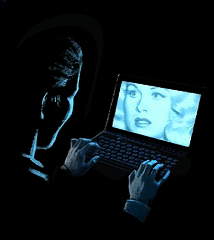"Mr. Barbicane Takes A Trip" Chapter Four
On the other side of the door he found the air thick with the fumes of jet exhaust, a singularly exciting scent. Concrete spread out in all directions to the horizon. Ahead of him, above him, waiting, was a silver Boeing MD-87 built in 1994 at the Boeing plant in Long Beach, California.
The overall length of an MD-87 is one hundred and thirty feet four inches, with a wing-span of one hundred and seven feet eight inches, and a height at its tail of twenty-nine feet six inches. It’s maximum take-off weight, which in the configuration Mr. Barbicane was about to board consisted of the weight of the airframe itself added to the weight of one hundred and thirty passengers, nine hundred and thirty-seven cubic feet of cargo and seven thousand U.S. gallons of JP-4 jet fuel, plus its two Pratt and Whitney JT8D-217C engines (which can generate a total maximum thrust of twenty thousand pounds), was one hundred and forty-nine thousand pounds, or seventy-four and a half tons. The MD-87 is capable of attaining speeds of up to five hundred and four miles per hour, which is just over three quarters of the speed of sound, with an effective range of four thousand three hundred and ninety-five nautical miles. Boeing terminated production of the MD series in December, 1999.
It seemed to Mr. Barbicane that there was nothing so beautiful, so emblemic of all that is good in modern man as the sight of this metal skinned machine that seemed to loom over him like the frozen form of some ancient beast on display in a museum. The closer he went, the more his perspective was distorted, the larger the nose of the plane became, the longer its body, the more distant it towering tail.
Soon he would be within the beast, a part of it. Soon he would lose all control over his life, surrendering it to this construct of metal and plastic. He would be taken in and once inside he would not only be forbidden by federal law to interfere with the operation of the aircraft in any way, he would be intellectually prohibited from doing so.
Often he looked to the left when he stepped onto a commercial aircraft, hoping the door to the cockpit would be often. In there he glimpsed a room crowded with information and controls, their purpose and intelligence beyond Mr. Barbicane’s understanding. His ignorance of these items made him giddy. And carved out of the wall of controls, a horizontal window looking out over the abbreviated nose of the aircraft. Looking straight ahead, a direction no passenger was permitted to share; all Mr. Barbicane and the others were permitted was a sideways vantage point. They could look off to either side, but could not see forward, they could not see ahead of them. They could not see where they were going. It would be too much for average mortals. On board he would be useless. He would be without purpose. He would be…the word rose in his chest on a bubble of expectation…a passenger.
He climbed the steps to the forward cabin door. For a moment he was level with the swept wing to his right. He glanced over, at the rounded edge of metal, at the circular dots of the counter sunk rivets holding the wing together, holding it to the fuselage. He saw apertures and divots, tiny pieces of metal thrust up from the skin, small spaces marked with codes and everywhere tiny yellow warning stickers, the simple, oft repeated, non-negotiable shibboleth: NO STEP.
At the top of the stairs, while the line of people ahead of him was temporarily stalled by some congestion inside the aircraft, he looked around, looked back. He looked at the cracks in the tarmac below. He looked at the seal around the cabin door. He was going on a trip. He would be leaving soon. He would be unavailable, in transit, on his way. He would be neither here nor there.
There was unseen resolution in the cabin ahead of him and the march of people resumed. A moment and Mr. Barbicane stepped into the aircraft, stepped over a narrow crack, a gap between the edge of the top of the rolling stairs and the threshold of the cabin door. Through this gap morning sun bounced up from the pavement and burned a brief slash across the inside of his eyes, a slash that remained like a ghost on his vision for several seconds once he had crossed over to enter the machine.
There was a woman there in a blue-gray uniform with hair the color of a raven’s wing. She had olive skin and smiled at Mr. Barbicane and asked if he knew where he was going. The context of this question was restricted to his placement in the aircraft and not what is referred to as his final destination. He told her he did know where he was going and started down the long tube of regimented seats.
He did not march far, because Mr. Barbicane, thanks to the timely use of frequent flyer miles, was traveling in the first class cabin. He located his window seat, placed his bag in the overhead compartment and dropped into his seat, immediately fastening and tightening his seat belt.
The plastic outer covering of his window was etched with a hundred thousand miles of scratches, the result of sub-sonic sand and dust shrieking along the side of the aircraft. With the sun at its current angle, each crack dragged a razor thin rainbow across his vision.
Mr. Barbicane made sure his seat was in its full upright position then placed his hands on the two arm rests and sighed. He closed his eyes and waited to be transformed.


0 Comments:
Post a Comment
<< Home